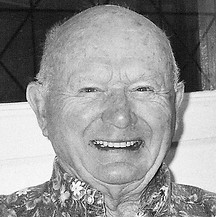2008 Hall of Fame

Thomas M. Shoemaker
Thomas M. Shoemaker is well known for taking over as editor and author of The Lineman's and Cableman's Handbook or "Lineman's Bible", in 1970 at the request of Edwin B. Kurts. Born in Geneva, Indiana in 1921, Shoemaker joined the army in 1943. After graduating from the Long Lines Plant Telephone Carrier School he served in the Pacific Theatre during WWII. Shoemaker later earned a B.S. degree in electrical engineering from the University of Iowa and went on to spend 40 years working for Iowa-Illinois Gas and Electric Company, where he was instrumental in starting many of the safety and training classes and procedures still in use today. Shoemaker remained involved in professional organizations throughout his career, including the Institute of Electrical and Electronics Engineers, the Power Engineering Society, and the Edison Electric Institute, and attended and spoke at conferences focusing on the industry and safety.

Alan E. Drew
At the early age of six, Alan E. Drew started climbing backyard poles. His curiosity about electricity carried him through his apprentice lineman training, completed in 1962, a degree in Electrical Power Engineering, completed in 1975, and more than 45 years of experience in the industry. Alan has worked in many areas of the field, including engineering, construction, operations, training, and education, and is admired and respected as an ambassador for the trade. Alan played a key role in the development of the Northwest Lineman College's correspondence based Power Delivery Program apprentice lineman curriculum and has tirelessly collected trade memorabilia and artifacts for display at the college's historical museum. His love of books and passion for knowledge led NLC to name their student library the Alan E. Drew library on his 59th birthday.

Andrew L. Freeman Sr.
Born in Upham, North Dakota in 1909, Andrew L. Freeman Sr., graduated from the University of North Dakota with a B.S. in electrical engineering in 1932, emerging from school during the Great Depression. Holding a variety of jobs over the next eight years, Freeman settled as manager of the Minnkota Power Cooperative in 1940, and has spent more than 60 years in the position. In 1947 he patented "the Freeman Headbolt Heater" and formed the Five Star Manufacturing Company to manufacture it. Freeman received many awards during the course of his career, including the Inventor of the Year Award (1957), the Rural Electrification Administrator's Award (1971), the Nikola Tesla Award (1969), and the distinguished UND Sioux Award.

Randall "Randy" States
Randall "Randy" States has dedicated more than 58 years to promoting and fostering the lineman tradition. Born in Detroit, Michigan, Randy began his career as an electrical helper with Niagara Power and became a journeyman in his early 20s. After 11 years with Niagara Power and another eight with the City of Los Angeles's Department of Water and Power, Randy took on the responsibility of teaching the next generation of electrical helpers and line apprentices. His dedication, instruction, and availability as a mentor have touched more than 3,000 career lineman, apprentices, and electrical helpers since he began teaching in 1969. Even after retirement, Randy has continued to encourage and cheerlead teams of linemen and apprentices in lineman rodeos.

Bill Boell
Bill Boell began his more than 50 year career as an apprentice lineman for Henkels and McCoy in1958. Admired by coworkers as, "one of the most dedicated lineman around," Bill has worked as a foreman, general foreman, supervisor, operations manager, division manager, vice president, and senior vice president. Even in his current role as senior vice president, Bill still spends time in the field with crews, listening to and helping them.

George Westinghouse
George Westinghouse was an innovative inventor and entrepreneur who formed and directed more than 60 companies to promote and sell his inventions and those of other innovators of the time. Some of his most important contributions to the field of electricity supply and construction include the forming of the Westinghouse Electric Company in 1887, and obtaining the rights to Tesla's patents for a polyphase system of alternating current in 1888, putting himself in direct competition with Thomas Edison and The Edison General Electric Company that provided DC service. His company was awarded the contract to build three generators for harnessing the energy of the Niagara Falls into electrical power in 1893, and by April 1896, only a year after installation began, engineers closed the circuits in Buffalo and the power of the Niagara Falls was available.
